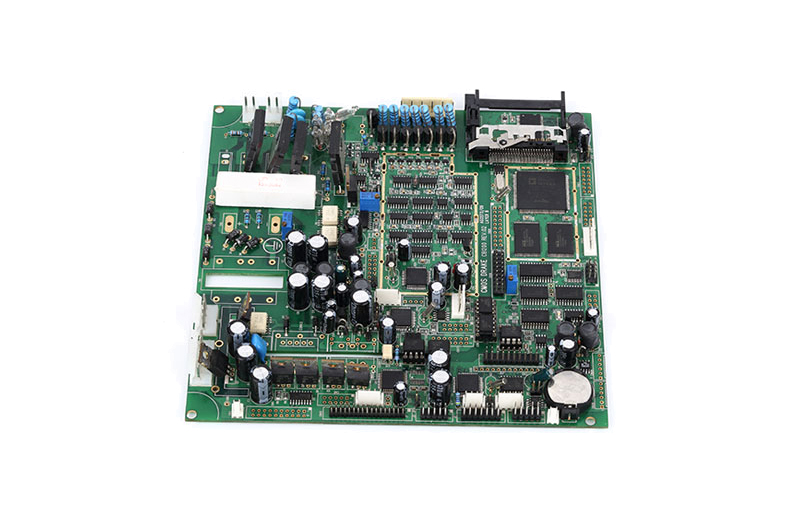
Ensure the accuracy of design documents and BOM, purchase components according to the BOM, and the quality and supply stability of components are crucial to the success of PCBA proofing. Components electronic, such as processors, memory, etc., ensure the accuracy of component models, specifications and quantities, and conduct strict tests on them to ensure performance and quality, and meet design requirements.
According to PCBA design, a reasonable component layout can improve the overall performance of the circuit board. Based on the specific parameters of the PCB such as board thickness, number of layers, copper thickness, minimum line width, power distribution, ground connection method and spacing, the PCB assembly is processed.
Surface mount components are placed on the PCB board using an automated placement machine.
Welding is a key step in PCBA processing. Solder paste is melted by heating the reflow oven to form reliable solder joints. The welding temperature, time and selection of welding materials need to be strictly controlled.
PCB assembly production requires multiple inspection and testing processes, and automatic optical inspection equipment check the quality of patches and welding. Functional testing, testing instruments and fixtures are used to detect the function and performance of PCBA. Various tests can detect and deal with potential problems promptly to ensure the quality of the final product.
Flexible PCB is thin and bendable. It can be bent and folded during installation and is suitable for flexible layout in limited space. Suppose the space of the industrial control system is very limited or the internal space needs to be optimized. In that case, flexible PCB is the first choice, which can make the industrial control equipment have good vibration resistance. Therefore, the application of flexible PCB in the field of industrial control is extensive and diverse.
Industrial robots usually have multiple joints and require flexible connections to transmit signals and power. Flexible PCB can bend and rotate at the joints to ensure reliable transmission of signals and power. Inside the robot, space is usually tight, and flexible boards can be connected to very small or very complex spaces, optimizing the use of internal space.
In industrial automated production lines, sensors are distributed in different locations to monitor and control the production process. Flexible PCB boards can connect these dispersed sensors to the central control unit, improving the convenience of installation and maintenance and providing reliable connections.
In industrial computers and embedded systems, multiple modules need to be interconnected. Flexible boards can achieve high-density connections in a limited space, optimize pcba design, reduce the use of connectors and cables, and improve system reliability and performance.
Various industrial measuring devices, such as pressure sensors and thermometers, require complex printed circuit designs in a small space. The bendability and flexibility of flexible pcba can flexibly adapt to these needs.
Rigid PCBA has a stable structure, good thermal stability, relatively low cost, and stable performance in high-temperature environments, making it an indispensable key component in industrial control equipment.
Rigid PCB assembly can provide reliable signal transmission and power distribution. They are often used in the main control panels of industrial control equipment. They are responsible for the installation of the central processor, memory and various interfaces to ensure the stable operation of the equipment.
In industrial power management modules, rigid printed circuit board can be used to install key components such as transformers, voltage regulators, and filters to ensure the stability and reliability of power transmission.
The rigid board provides electrical connections to control the start, stop and speed adjustment of industrial control equipment and controls various actuators such as valves, relays and hydraulic cylinders to ensure precise motion control.
Rigid pcba are used in safety monitoring systems in industrial control equipment, such as emergency stop buttons, safety door locks, and photoelectric sensors, to provide reliable data acquisition and transmission to ensure safe operation of the system.
Rigid and Flexible PCBA, with both the flexibility of flexible PCBA and the mechanical strength of rigid boards. Rigid-Flex PCB is widely used in industrial control equipment in high-density wiring and complex signal transmission, which require certain mechanical strength and stability.
Heavy machinery such as excavators, cranes and bulldozers require highly reliable and vibration-resistant control systems. Rigid-flex PCBA can be installed in control modules, with the rigid part providing stable structural support and the flexible part realizing electrical connections between different modules.
Sensors distributed on various heavy machinery components are connected to the central control unit through the rigid-flex board. The flexible PCBA can adapt to mechanical movement, while the rigid PCBA provides stable connection and signal processing.
In embedded systems of industrial control equipment, modules such as CPU and memory must be closely connected. Rigid-flex printed circuit boards can achieve high-density wiring in a small space and improve system performance. The design of rigid-flex boards can improve the system's vibration and impact resistance and ensure long-term reliable operation.
Portable test instruments such as handheld oscilloscopes and multimeters require lightweight designs. Rigid-flex boards can optimize space layout, reduce the number of internal connectors and cables, reduce weight, and improve portability.
Prev:High Reliability and Stability of Beauty Equipment Printed Circuit Board
Next:Innovations In PCB Fabrication and Assembly for The Automotive Industry
